The Making of Mad Max: Fury Road
If you’re as excited about Mad Max: Fury Road as the rest of the world, then this round up of behind the scenes interviews, scene breakdowns and making of insights will give you a good look at how this epic action movie was brought to the screen. If you’ve not seen the film yet, then you might want to save this post for when you get back home afterwards.
Mad Max: Fury Road is now available to buy on Blu-ray and DVD, Amazon Instant Video and other streaming services. UPDATE – The film won 6 Oscars for best editing, sound editing, sound mixing, costume design, production design and makeup and hairstyling.
The Miami Herald has a nice write up on the film, including some nice insights on George Miller’s career, personal life and the creative theories he holds.
“Alfred Hitchcock said he wanted to make movies where people in Japan didn’t have to read the subtitles,” Miller says. “That is something that has influenced all the Mad Max movies. The audience has seen so many movies and video games and music videos and animes, they already know a lot of this stuff. I wanted to see whether we could pull off a long chase that takes place across three days, and the audience picks up what they need to know along the way — the characters, their back stories, what’s happening between them and the world they live in.
Vice Magazine kicks of a series of Film Talks with this chat with director George Miller, loosely broken up into four topics – Background, Characters, Logistics and his Filmography.
September 2020 Update – Behind The Scenes Documentary
Warner Bros just released this 40 minute behind the scenes documentary “Going Mad: The Battle of Fury Road” featuring lots of great behind the scenes footage and interviews with all the key creatives on the film. Enjoy!
UPDATE – Nathalie from Mentorless has put together a fantastically detailed breakdown of this 50 minute post-screening Q&A with George Miller on his creative process and many of the themes from the film. Jump over to her site to enjoy a treasure trove of insights.
Variety has a very long and detailed interview with director George Miller, again covering the evolution of his career and the 30 year process that went into making Mad Max: Fury Road.
DP/30 has a nice 30 minute chat with George Miller on his career, the journey to the screen, advances in technology, and much more.
If you’re a petrolhead then you may enjoy this featurette about the cars in the film, and this write up on production designer Colin Gibson’s mechanical masterpieces.
“War Rig was one built more to a prescription than an imagination,” he explains. “It was such an important part of the story that George and the storyboard artists had come to a greater consensus of what was required.” Gibson points out that there are up to 13 different characters inside the rig at any one time through the movie. Gibson said the classic John Wayne western, “Stagecoach,” was an inspiration for creating a moving location where the drama plays out over a long stretch of time.
As part of Graphic 2015, director George Miller, co-writer & illustrator Brendan McCarthy and co-writer and dramaturge Nico Lathouris discuss the film’s 12-year journey to the screen. It’s a fascinating discussion that covers a lot of ground so if you’re a fan of the film – it’s well worth the time!
Thanks to Lucantonio Elio for the find!
Filming Mad Max: Fury Road
If you want to spend two hours in the company of the Director of Photography of Mad Max: Fury Road, John Seale ACS ASC and 2nd Unit DoP David Burr ACS, then you’re in for a treat with this recording from the Australian Cinematographers Society. John starts the talk by walking through the stop-start timeline of the production and some of the technical challenges thrown up by George’s creative vision, 3D technical developments and the film’s evolved final production workflow. One thing that’s stands out is Miller’s propensity to solve most problems with “We’ll fix it in post!”
It’s pretty rare to get two hours with two DoP’s discussing the workflow and production challenges they encountered, and so even though this is a feature’s worth of chat, it’s a real gem! They cover the lenses they use, camera kits, working with George, working with a DIT, shooting day for night and a whole lot more. What’s more it’s all delivered with that wry Aussie sense of humour.
Seale’s crew was outfitted with six ARRI Alexas and a number of Canon 5Ds, with the latter used in part as crash cams in action sequences. The Alexas were supported by 11 Codex Onboard Recorders… In order to provide maximum image quality and flexibility for post-production manipulation, Seale and his crew chose to record ARRIRAW with the ARRI Alexa cameras. That, the cinematographer noted, made Codex an obvious choice as only Codex recorders were capable of reliably capturing ARRIRAW.
Definition Magazine has a fantastic write up on the film’s production, which provides a lot of nice details of the film’s technical workflow considerations.
Hit Film also has a great interview with DoP John Seale that covers a lot of the same information as in the 2 hour conversation above, so if you want a few highlights from it in a quick fashion then this interview will deliver the goods.
Studio Daily also has a breakdown of the film’s production, including a nice video (only embedded on Studio Daily) of some of the production in action.
Miller has been around long enough that he wanted to capture the action on location and in camera rather than resorting to green-screen shoots on soundstages and CG composites in the final film. But one stunt seemed to be too difficult to shoot practically—Miller wanted the attacking “war boys” to use long poles that would swing them overhead, their trajectory arcing down toward other vehicles. The stunt team finally developed an upside-down metronome rig–basically a 30-foot pole counterbalanced by an engine block attached at the base, underneath a fulcrum. The stunt team pushed and pulled the block, coordinating their movements with the performers on the poles, who stayed in touch via earpieces. “When I saw this footage, it brought tears to my eyes,” Miller said. “I thought anything we tried would be way too unsafe to do it for real, but those guys were completely safe up there. They could stay up there all day.”
UPDATE: With the release of Mad Max: Fury Road on Blu-ray, DVD and streaming services, Studio Daily has a really interesting article with coordinating camera assistant Michelle Pizanis on the gargantuan task of keeping tabs on all of the cameras in use across 84 full filming days of the film’s 120 production days.
Not one camera failed as a result of the conditions on location either, says Pizanis, although there was plenty of back-up built into the workflow: Six ARRI Alexa Plus and four ARRI Alexa M cameras recorded to 11 onboard Codex recorders as well as in-camera to SxS cards. “Each camera was fully independent of one another,” Pizanis says. “Each one had its own remote focus device and its own set of zooms so they could work independently but also at the same time so we could capture all of it.”
UPDATE – John Seale in BAFTA Guru Interview
In this BAFTA Film Sessions you can hear from Director of Photography John Seale, on the experience of shooting the film.
Mad Max: Fury Road Post Production
In this anatomy of a scene from The New York Times, director George Miller, you get to hear him talk about the importance of working with a great editor, who just happens to be his wife.
In order to make it seamless – it seems to be chaotic and raw, but you want it to be creamy and seamless, and that depended on Maragret Sixel, the editor. And you finally get all the bits together, I think there might be close to 2oo hundred shots which might only last a little less than two minutes, and it was up to her to actually find the connections, between one shot to the other to make it creamy and fluid, so it’s a little like cutting a dance sequence.
There are good few details on her post production workflow in the Variety interview too.
Meanwhile, back in her edit suite in Sydney, Sixel greeted each new day with a mix of awe and trepidation. The footage coming in from the set was duly spectacular, but there was so much of it – anywhere from three to six hours’ worth per day, nearly 500 hours in all – that it took a herculean effort just to catalogue it all…. We felt, by the end of it, there was not a frame in the rushes that we hadn’t thought about or tried, and that takes a long time.”
According to John Seale (in the 2 hour video above) because George wanted every shot to move the story forward and to be able to cut quickly, they were always trying to frame up the action centrally so that the viewers eyes wouldn’t have to move about the frame.
George is very specific about frame rates. I don’t think there’s a single shot in the film that’ over 24. It’s all under. In post he’s very pedantic about how fast that shot should be. I’ve heard him say ”show me 7 frames a second, show me 6… 5. OK I like 6.” – John Seale.
“Too often, if you just cram a lot of stuff into the frame, you get the illusion of a fast pace. But there’s no coherence. It doesn’t flow. It comes off as headbanging music, and it can be exhausting. We storyboarded the movie before we had a script: We had 3,500 boards, which helps the cast and crew understand how everything is going to fit together. Movies are getting faster and faster. The Road Warrior had 1,200 cuts. This one has 2,700 cuts. You have to treat it like a symphony. Hopefully audiences will appreciate that.” – George Miller
Update: The Huffington Post has a nice article on Margaret, focusing on what it’s like to be an editor, a mother and a wife to a filmmaker – all at the same time.
“It wasn’t that it wasn’t my genre. We have two boys together; George would be away for eight months. It’s a lot to take on — almost a three-year job. In that context, I had to figure it out. Once I decided, I was determined to finish.” She laughs, “I haven’t gone out for almost three years. I’ve been sitting in a room. It’s the least glamorous side of the industry.” “My boys were very into the film and supportive. If they saw me stressed they’d say, “Mum, you are the only mother in the world cutting an action film. Do you know how many people want your job?”
“Editing this film was tough because there’s very little dialogue, which is how scenes are structured, so the options are endless. It was a relief to find a scene with dialogue. You cut them in a day. It’s ridiculously easy. The biggest challenge are notes from test screenings. You can’t get defensive. You focus and try and address it. But there are times when you have to say, ‘I’m not doing this.’ There was a point in the last few years where I decided I didn’t mind not being liked. It gave me courage. You can’t lose your integrity because someone in the test audience didn’t like it.”
UPDATE: Avid has a really good write up of an interview with Margaret, including some nice details about her creative methods inside Media Composer. Well worth a read, even if you’ve already read all the other links!
“In Mad Max: Fury Road we experimented with speed ramps, a technique George had used on the earlier Mad Max films. Now with Avid Media Composer it is far more sophisticated as there is greater control. We used heaps of key frames to refine the ‘time warps ’. We also re-racked, enlarged and repositioned shots for eye scan. George has always manipulated his material like this, but before digital editing the labs had to do it all optically. Nowadays the Avid makes it so easy. The picture-in-picture tool certainly had a workout on this movie.”
UPDATE – Oscar wins!
Margaret Sixel won the Oscar for Best Editing at the 2016 Oscars for her work on the film, which also won 5 other Oscars including best sound editing and sound mixing. The LA Times has a nice little interview with her here, which Natalie from Mentorless.com has done a good job of extracting some wisdom from and writing up in this post.
I wanted every single shot to progress the story. I don’t like repetition. And I think we applied that rule religiously throughout the film.
The rule being “No similar shots”?
Or ones that have no added information. I watched a film last night and they kept cutting back again and again and the expression on the actor’s face was exactly the same. I felt like, “You’ve used the shot three times already!” That’s what I don’t like. There’d better be some progress.
There is also an excellent National Public Radio (NPR) interview with Margaret, which you can listen to below or read through a transcript of here.
We figured that it would take three months just to watch footage before you could actually do any work. It was a huge task, and I have to confess, some days overwhelming. But basically, how do you shape such a film? You go in every day, you bite off a little bit, you cut it to the best it can possibly be, and you start building up your cut that way.
UPDATE: Steve Hullfish interviews Margaret as part of his Art of The Cut series over on PVC. Something I hadn’t really fully absorbed yet was the sheer magnitude of the task at hand. These two quotes from the beginning and end of the interview really sum it up. As always from Steve, a fantastic interview and a great read.
HULLFISH: Congratulations on your Oscar win! What was the post schedule like from the beginning of principle photography (or even before) through to the DI and mix.
SIXEL: It was a long schedule by anyone’s standards but this was not your average film. The crew were in Southern Africa (Namibia and Cape Town) for 8 months and then we cut for an additional 2 years. I was on the film roughly from March 2012 to April 2015 with a few breaks. During preproduction I was cutting together casting sessions, working on some previz, the animatic and generally worrying about everything. A year after principal photography had finished we had an extra 3-week shoot so we didn’t have a complete film that we could evaluate until February 2014. We kept tweaking right into the final mix (April 2015) but as they say “a film is never finished, it’s just taken away from you.”
…
HULLFISH: Any final words of wisdom?
SIXEL: I don’t think young editors realize how tough it can be. Especially on big budget films where there’s a lot at stake. “Fury Road” really exhausted me on many levels. You have to look after your health and sanity. I think my greatest achievement was remaining objective right to the end.
Mad Max Fury Road – Centre Framed
Editor Vashi Nedomansky has put together a great little breakdown, along with some commentary from the John Seale video above, on the synchronicity of centre-framing between production and post, that helped to provide the film it’s electric pace. Well worth a read.
One of the many reasons MAD MAX: FURY ROAD is so successful as an action film is the editing style. By using “Eye Trace” and “Crosshair Framing” techniques during the shooting, the editor could keep the important visual information vital in one spot…the Center of the Frame. Because almost every shot was center framed, comprehending the action requires no hunting of each new shot for the point of interest. The viewer doesn’t need 3 or 4 frames to figure out where to look. It’s like watching an old hand-drawn flip book whiz by. The focus is always in the same spot!
UPDATE: The Fastest Cut
Vashi has put together another really interesting video, featuring the cutting of Fury Road, in which five different action films are played side-by-side, at 12x speed, for their entirety to compare the comprehensibility of their cutting style and average shot length. Definitely pop over to read Vashi’s thoughts on this in the full post.
For a little bit of fun here is a trailer for Pixar’s CARS restyled as Mad Max: Fury Road.
Mad Max: Fury Road – The Wired Articles
Wired Magazine has a great collection of articles on Mad Max: Fury Road, all of which are worth a look.
Wired – What It Takes To Make The Most Intense Movie Ever
The stunt crew and George were all into trying to make stunts real and do them practically as opposed to doing them on a green screen. You’re very protected as an actor a lot of the time. On Fury Road, we were protected, but a lot of the time, well, you were also hanging under a truck with a harness. They’re saying, “Don’t scoot too far this way or your head will end up under the front wheel.” All around you, cars are crashing and flipping. Some incredible stuff happens. It makes your life as an actor easy, actually. You’re not even thinking about the acting. You’re just being put in this real situation. – Nicholas Hoult
Wired – Nicholas Hoult – Crazy Real Stunts
“George and I laugh quite often about it all, since I turned 21 during the making of Mad Max 2, when the most sophisticated safety equipment we had were cardboard boxes,” says Norris. “Crashing a ten ton truck was a nice way to go out.”
Wired – Mad Max Stunt Coordinator
Colour Grading Mad Max: Fury Road
Update May 2020 – Vincent Teoh from HDTV Test takes a close look at the 4K Ultra HD edition of Mad Max: Fury Road in this interesting video.
If you’re keen on watching Mad Max at it’s best at home, this might be what you want to go for. That and a 4K HDR TV, like the 55″ LG OLED I reviewed here.
I’ve also reviewed this excellent colour grading training from Filmmaker U and Mad Max: Fury Road colorist Eric Whipp, over in this detailed post.
It’s an amazing course which will inspire and inform colorists of all levels and Eric makes for a highly engaging and thoughtful instructor. Don’t miss this opportunity to sit with a professional colorist of this stature!
You can check out Eric Whipp – Colour Grading Secrets from The Mad Max Colorist for yourself on Filmmaker U and save 10% with the exclusive coupon code “JONNY“.
Mad Max: Fury Road was graded by Eric Whipp (for a very long time…) on a Baselight, and hopefully Filmlight will provide a nice write up, or possible even a video interview in due course. The quote in the tweet below demonstrates just how much ‘fix it in post’ there really was, which is taken from this interview with John Seale.
Filmlight has delivered the goods in this ‘Meet the colorist’ interview with Eric Whipp who discusses the technical, creative and collaborative aspects of colour grading Mad Max: Fury Road.
Fury Road had a very unusual post-production pipeline in terms of colour. We had the luxury of a very long post period which was great for look development and for the ability to re-visit grades. I started setting looks on early cuts of the film in February 2014, with George in Sydney. I then essentially took the film back with me to Alter Ego in Toronto where I worked on it over the next year. We would do interactive grading sessions with George over our StudioLink system. This worked amazingly well and enabled George to sit in a theatre in Sydney and interactively grade with me at Alter Ego in Toronto.
It’s interesting to note how much work went into all that ‘fix it in post’ from George and John on the set – with the colour grading team performing hundreds of sky replacements and roto’ing almost every single eye-ball on screen.
Apart from the challenges in creating a hyper-colourful, rich and graphic look, John knew that lighting continuity wasn’t perfect. The shoot was over six months – and ran at a frantic pace – so the grading process was used to iron out some of the daylight differences between shots to help cut between a sunny day and a cloudy day, for example.
George is also a strong believer that an audience should focus on character’s eyes. We spent a lot of time ensuring that the attention in any given shot guided you towards the eyes or whatever the important action might be in the frame.
According to this article in Collider there will also be a black and white version of the film on the Blu-ray release. (NOTE – The B/W trailer above is fan made, not official.)
“We spent a lot of time in DI (digital intermediate), and we had a very fine colorist, Eric Whipp. One thing I’ve noticed is that the default position for everyone is to de-saturate post-apocalyptic movies. There’s only two ways to go, make them black and white — the best version of this movie is black and white, but people reserve that for art movies now. The other version is to really go all-out on the color. The usual teal and orange thing? That’s all the colors we had to work with. The desert’s orange and the sky is teal, and we either could de-saturate it, or crank it up, to differentiate the movie. Plus, it can get really tiring watching this dull, de-saturated color, unless you go all the way out and make it black and white.”
UPDATE Sept 2016 – The Black and Chrome Blu-ray edition will be released on Dec 6th!
One of the biggest colour grading challenges was the day for night sequence, whose innovative ‘over-exposed’ workflow, is detailed in this FX Guide article. The image above is an original plate and the image below the final frame.
Jackson’s observation was that the higher exposure, the better the image is – assuming no clipping has occurred – something that he felt could be replicated by shooting with the ARRI Alexa. His rational was that an overexposed image would contain more detail and less noise, and on the Alexa would roll off into the highlights while not quite clipping, and therefore be suitable for grading from day to night. “I did some tests with the day for night idea with digital stills,” adds Jackson. “The massive benefit you get with shooting overexposed for a day for night setup is that you get detail in the shadows that’s still there. You can pull the highlights down and darken the whole image, but still have detail in the shadows. It doesn’t just clip to black in the shadows.”
During grading, Whipp took advantage of the latitude in the Alexa to deliver the day for nights. “When I first started grading the scene,” recalls Whipp, “I was in a little bit of shock – literally you have these people running around in full sunlight. There were shots in the film with lens flares, people are literally squinting into the sun and the lens flare is hitting the camera and it’s two stops overexposed in full daylight – how am I supposed to make this work?”
The article then goes on to detail a lot of the sky replacement work (and other major tasks) colorist Eric Whipp had to perform in Baselight, with a lot more detail than the Filmlight interview.
UPDATE: Post Perspective has a nice interview with colorist Eric Whipp, which has some nice details in it.
How do you work with the Baselight? Can you just talk a little bit about the tool itself?
I think that Baselight is one of the few grading systems out there that can do mini-visual effects type work. It’s quite powerful. The way we approached this film was not just your typical 3-4 weeks of color grading at the end of a movie; it really became the finishing suite.Can you explain that?
All the visual effects would come in and everything passed through the Baselight. We took mattes from visual effects and the raw footage and put everything together. We tried to tidy it all up because there’s lots of tiny effects work that we would do in Baselight, like sky replacement and other little mini-comps. The goal was to finish everything and get it as smooth and silky as possible.
UPDATE: – Adding shake at the last minute
The fight scene between Max and Furiosa that was my first fight scene, and it was such fun to cut. It was very well choreographed, so that made it a lot of fun. It’s like a piece of ballet, really.
Max grabs the gun, and he’s pinned Furiosa to the ground, and then he fires the gun in the sand around her head. You know, right at the last minute where we do the color grading and you can manipulate the image, we actually put a shake on the shot, and so as the gun goes off, it just shuddered.
And we did that right then and went, “Yeah, that’s great!” And so we went through the film and thought, “Let’s put shake everywhere.” So we just made the film even crazier.
Margaret mentions in this NPR interview that they added an extra element of ‘craziness’ to the film at the last minute during the grade.
UPDATE – LowePost Community Interview
Eric Whipp shares some personal insights on grading the film over on the new colorist community site, Lowepost.com.
The one thing I was very conscious of was to make sure there was some sort of “grit” to the image. We didn’t want to make an overly plastic or fake looking saturated image, there needed to be some sort of rawness in the look as well.
In general, one of the aspects of the look was to apply a lot of sharpness. We liked how it made the image look sharp and how it often brought out some grit in the image. Each shot was sharpened independently and often we sharpened just certain parts of the frame more than others to help draw attention to specific areas.
This is one of the free articles from the site which is dedicated to colorists sharing insights on crafting feature films, commercials, music videos. To read more detailed articles you’ll need to snap up a yearly subscription at $59.
Visual Effects on Max Max: Fury Road
When you look at the visual effects breakdowns from Art of VFX and VFX Guide, it becomes readily obvious just how much work as done in post to create each final image. Although George Miller might have been adamant a lot of work was done practically on-set, there is a tremendous amount of work to ‘fix it in post’ going on here too.
The extensive FX Guide article, features a detailed interview with VFX Supervisor Andrew Jackson and Colorist Eric Whipp, peppered with a whole host of comparison background plate and final images, short video clips and CGI layers. Well worth the time to read in full. (As a quick note The Verge has taken the before and after shots in the FX Guide article and turned them into a trio of nice interactive sliders which are worth a play.)
“I’ve been joking recently about how the film has been promoted as being a live action stunt driven film – which it is,” says Jackson. “But also how there’s so little CGI in the film. The reality is that there’s 2000 VFX shots in the film. A very large number of those shots are very simple clean-ups and fixes and wire removals and painting out tire tracks from previous shots, but there are a big number of big VFX shots as well.”
Further more there is another good interview with Jackson over on Art of VFX, that is well worth a read too, that focuses on some of the wider creative and logistical challenges.
What was the main challenges and how did you achieve it?
Overall I think the main challenge was accommodating George’s schedule, while keeping focus. We had a 30 month post in the end which is an extraordinary length of time to be working exclusively on one show. Scenes would be turned over to us one by one and we would set our own deadlines to apply the right pressure to the team. A project of this structure could easily spiral the budget out of control, but by adapting our team size constantly we kept on track. Creative focus was a different concern. Fortunately the sequences are so different, but they follow the central thread, so each one brought fresh challenges and looks. George has an amazing capacity to hold it all in his head and keep us on track.
Indie Wire has a nice little article on the visual effects work to create the super storm sequence for the end of Act 1.
We sourced a huge amount of real twister footage to find visceral effects we liked and thought would work well for this sequence. The main, large core of the twisters were 3D volumes, almost entirely shader-based, allowing internal lighting. These were then wrapped in multiple, dense particle simulations that connected to the ground and sky. The sky was a 3D, animated matte painting created as numerous layers in Photoshop and assembled in Nuke. As the plates were shot in full sun, the vehicles were tracked and partially re-lit in CG to sit in the dark environment.
Mike Seymour from FX Guide provides a nice 3 minute look at the stunts and car chases, grading, visual effects and more. Well worth a watch! You would also be well advised to check out the hour long VFX Show podcast focusing on Mad Max: Fury Road.
VFX Supervisor Interview
As part of their Oscar coverage, Studio Daily has a nice interview with Mad Max: Fury Road, VFX Supervisor Tom Wood. He speaks about the exhaustive work performed by VFX supplier’s Method and Iloura, which largely revolved around the giant storm sequence.
How long did you work on the film?
We had two and a half years of compositing. The intent was to shoot as much as possible and put it back together the way George [Miller] wanted in post. He cut progressively from reel one on through and delivered the scenes chronologically. So we didn’t see anything more than the first reel and the beginning of the second reel for the first year. We’d work on one scene, and then as we finished that one, another would come in.
At 5 mins 22 into this BAFTA Film Sessions highlights video you can hear from the film’s VFX Supervisor, Andrew Jackson.

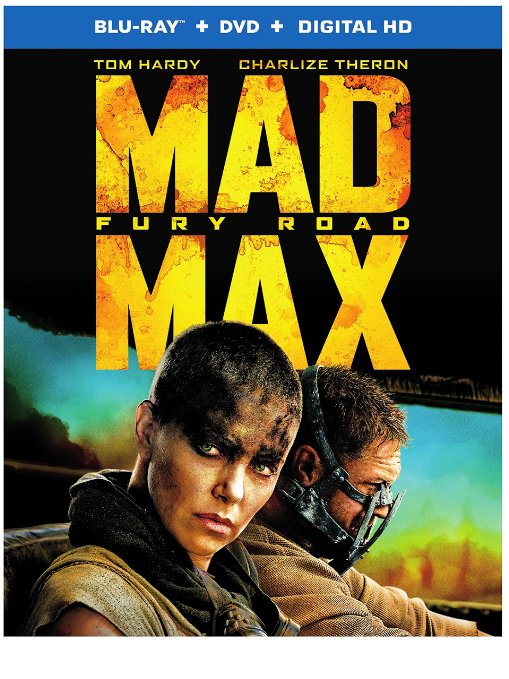

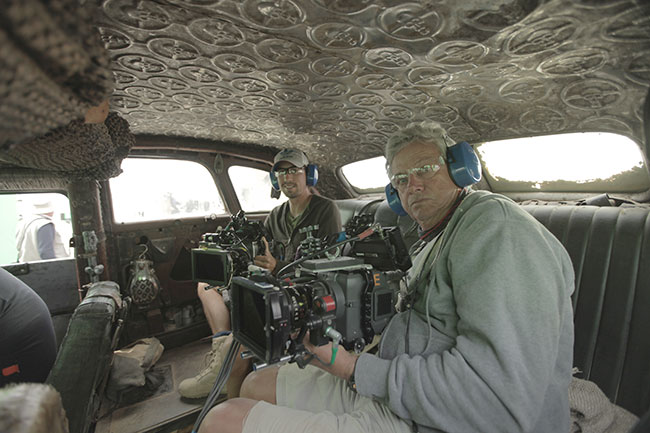
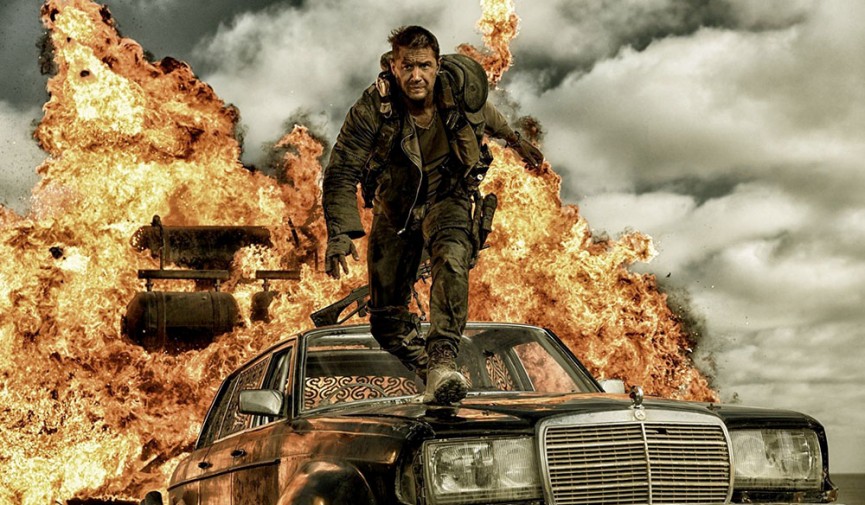
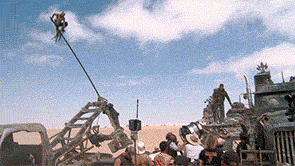
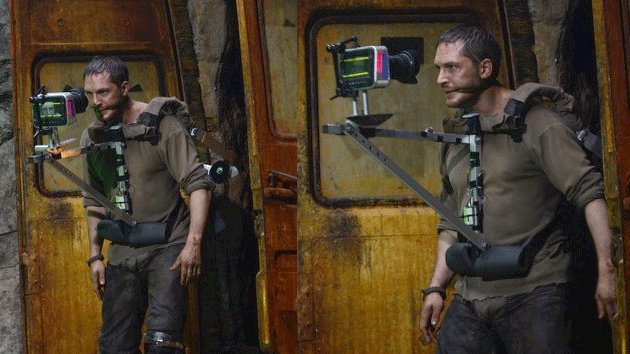

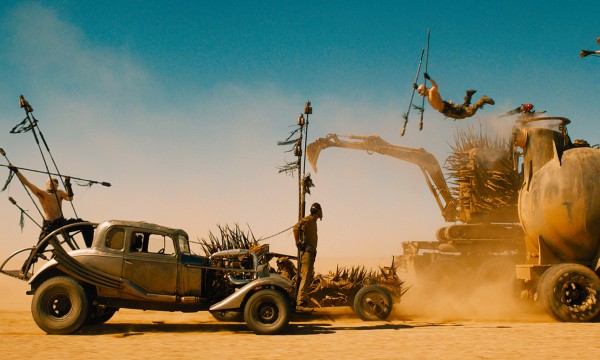

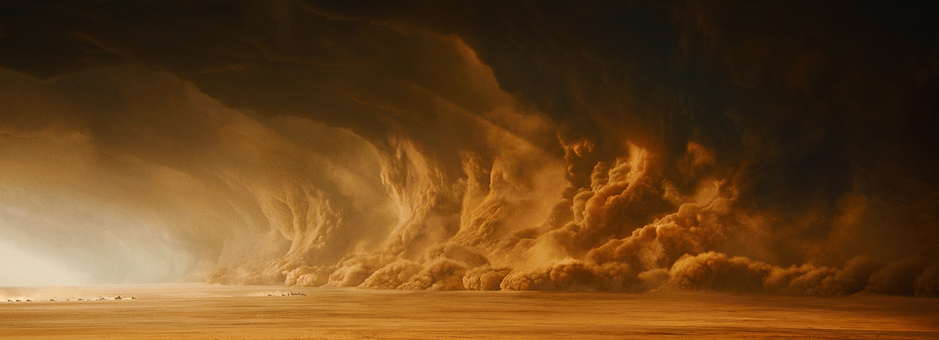
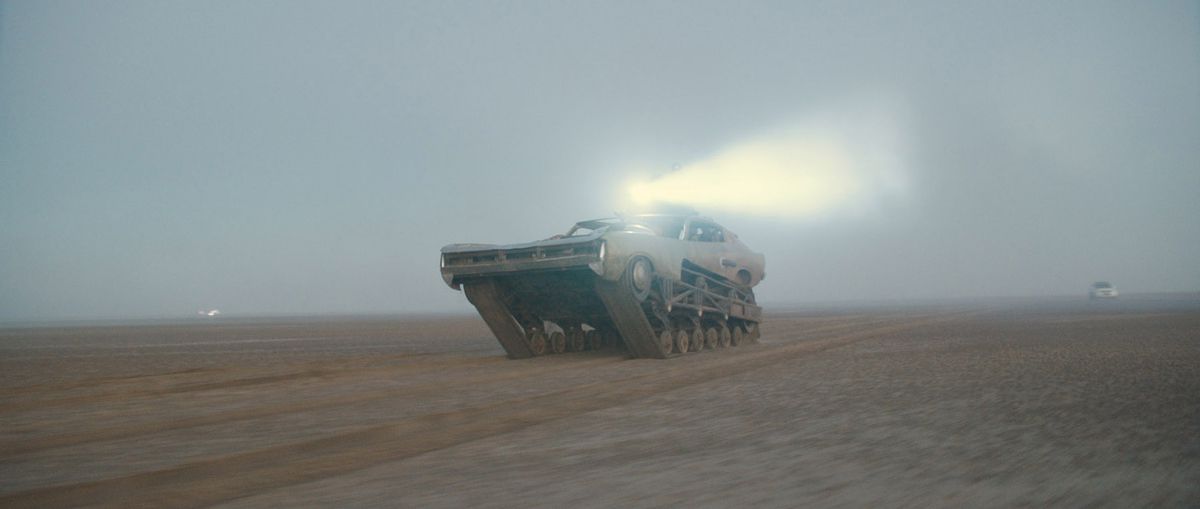
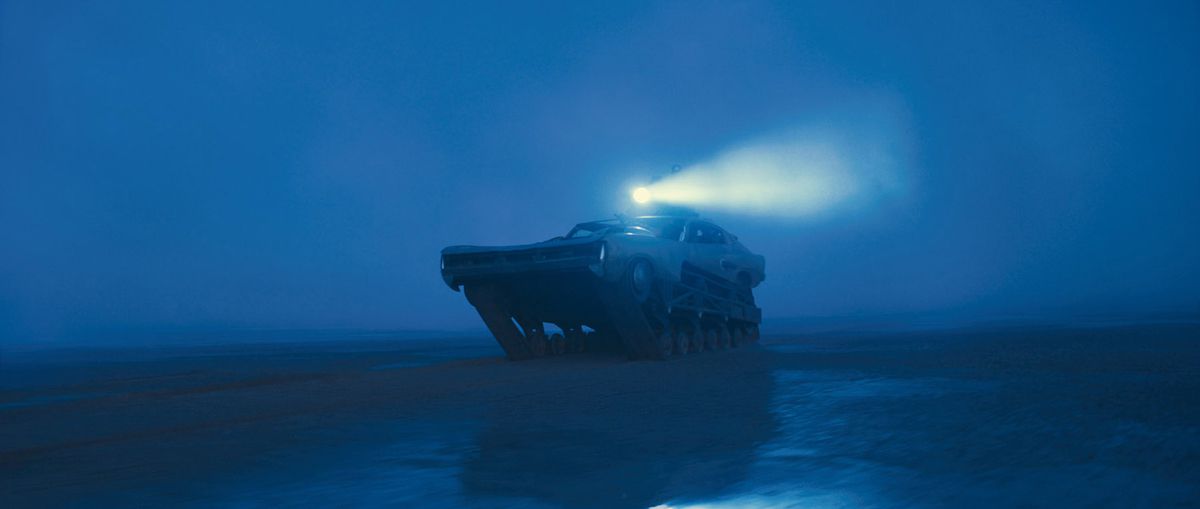
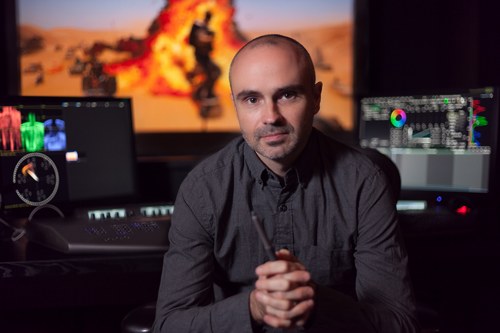
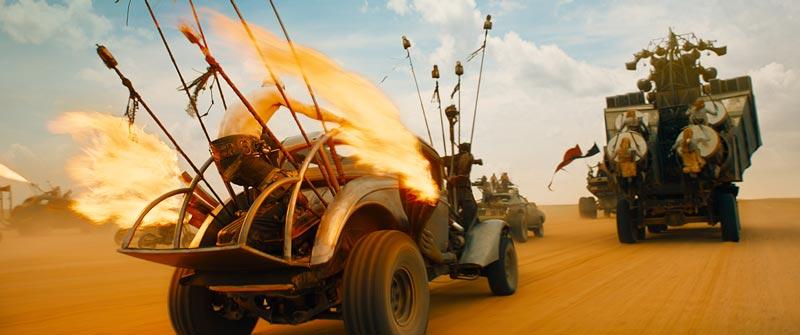
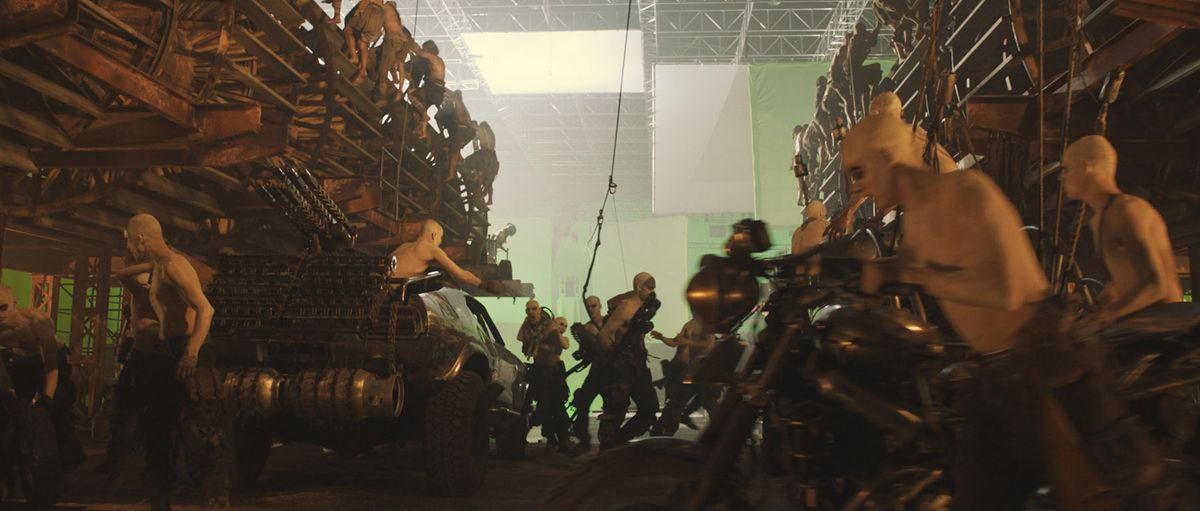
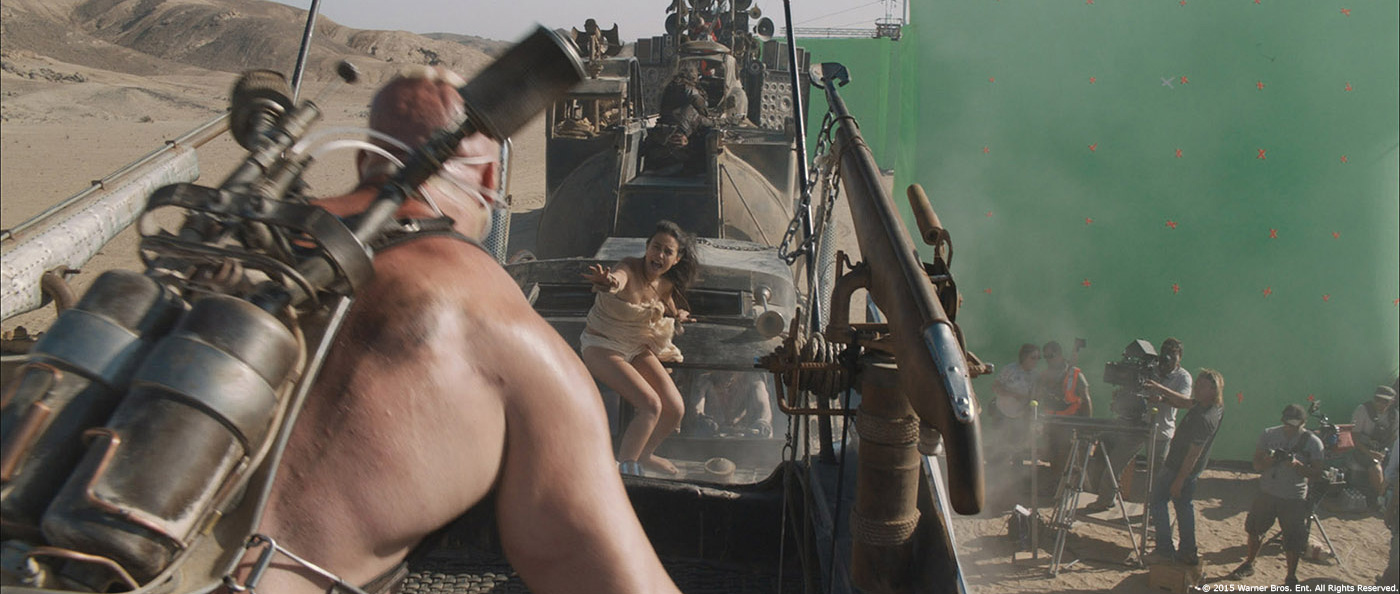





Love this site and totally blown away by this collection. Thank you!!
My God what a wonderful collection of information on the making of this incredible film! Thank you so much. I was expecting to do a ton of research to find some of this, and then I found it all together here. Many thanks!
Thanks Derek. Glad you found it.
Great resource of info! Cheers.
Probably the best trailer (nr. 2) ever made and an amazing film.
Anyone know who edited the second trailer?
The trailer was produced by the advertising company Open Road. I believe the editor was Kathleen Philips.
Great info! Great movie – proving once again you don’t need to be 20 to make good cinema…